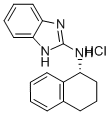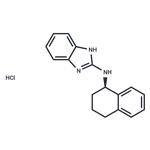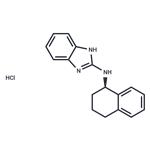NS 8593 is an inhibitory gating modifier of small-conductance calcium-activated potassium (KCa2/SK) channels (Kds = 0.42, 0.6, and 0.73 μM for KCa2.1/SK1, KCa2.2/SK2, and KCa2.3/SK3, respectively, in the presence of calcium) that decreases the calcium sensitivity of SK channels. It is selective for KCa2/SK channels over intermediate- (KCa3.1/IKCa1) and large-conductance (BK) potassium channels at 10 μM. NS 8593 induces relaxation of potassium- or acetylcholine chloride-precontracted isolated tracheal rings from wild-type mice (IC50s = 8.9 and 39.8 μM, respectively) or from mice in an ovalbumin-induced model of allergic asthma (IC50s = 16.4 and 32.2 μM, respectively). It inhibits aerosolized acetylcholine chloride-induced increases in respiratory system resistance in mice when administered as an aerosol at a dose of 500 μM. NS 8593 (5 mg/kg) decreases the duration of burst-pacing-induced atrial fibrillation in normotensive and spontaneously hypertensive rats.
NS8593 hydrochloride has been used to study its effect on the growth of MDA-MB-231 cells (M.D. Anderson and metastasis breast cancer cells).
The compound (R)-N-(benzimidazol-2-yl)-1,2,3,4-tetrahydro-1-naphtylamine (NS8593) reversibly inhibited recombinant SK3-mediated currents (human and rat SK3) with potencies around 100 nM. NS8593 did not inhibit 125I-apamin binding. NS8593 decreased the calcium sensitivity by shifting the activation curve for Ca2+ to the right, only slightly affecting the maximal Ca2+-activated SK current. NS8593 inhibited all the SK1-3 subtypes Ca2+-dependently (Kd = 0.42, 0.60, and 0.73 μM, respectively, at 0.5 μM Ca2+. NS8593 did not affect the calcium-activated potassium channels of intermediate and large conductance (hIK and hBK channels, respectively). NS8593-mediated inhibition was prevented in the presence of a high concentration of the positive modulator NS309.


